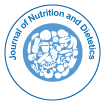Nutrigenomics: Understanding the Impact of Diet on Gene Expression
Received: 02-Nov-2024 / Manuscript No. jndi-24-155744 / Editor assigned: 04-Nov-2024 / PreQC No. jndi-24-155744(PQ) / Reviewed: 18-Nov-2024 / QC No. jndi-24-155744 / Revised: 23-Nov-2024 / Manuscript No. jndi-24-155744(R) / Published Date: 30-Nov-2024 DOI: 10.4172/jndi.1000268
Abstract
Nutrigenomics is an emerging field that explores the complex interactions between diet, nutrition, and gene expression. By studying how specific nutrients influence gene activity, nutrigenomics aims to provide personalized dietary recommendations that optimize health and prevent diseases. This article delves into the principles of nutrigenomics, its potential applications in personalized nutrition, and the implications for chronic disease management. As research in this area progresses, nutrigenomics holds promise for transforming dietary guidelines and improving public health through tailored nutritional strategies.
Keywords
Nutrigenomics; Gene expression; Personalized nutrition; Dietary recommendations; Chronic disease; Health optimization; Food-sensitivity; Epigenetics.
Introduction
Nutrigenomics merges the fields of nutrition and genomics to examine how food affects gene expression. This interdisciplinary approach sheds light on how dietary choices can influence biological pathways, ultimately affecting health outcomes [1, 2 ]. With the rise of personalized medicine, nutrigenomics is becoming increasingly relevant in developing individualized dietary interventions.
The Basics of Nutrigenomics
Nutrigenomics operates on the premise that genetic makeup can affect how individuals metabolize nutrients. This relationship can dictate dietary needs, susceptibility to certain diseases, and overall health [3]. Key concepts include:
Gene expression: The process through which genes are activated to produce proteins. Nutrients can influence this process, altering the function and activity of genes.
Epigenetics: Changes in gene activity that do not involve alterations to the DNA sequence. Environmental factors, including diet [4, 5], can lead to epigenetic modifications, impacting long-term health.
Nutritional genomics: A broader term encompassing both nutrigenomics and nutrigenetics, focusing on how genetic variation affects individual responses to nutrients.
Applications of Nutrigenomics
Personalized nutrition: Nutrigenomics enables the development of tailored dietary plans based on individual genetic profiles [6]. This can enhance nutrient absorption and utilization, leading to improved health outcomes.
Chronic disease prevention: Understanding genetic predispositions can guide dietary interventions to reduce the risk of chronic diseases such as diabetes, heart disease, and obesity. For instance, individuals with specific gene variants may benefit from diets rich in omega-3 fatty acids or antioxidants [7].
Food sensitivity and allergies: Nutrigenomics can help identify genetic factors related to food intolerances and allergies, allowing for better management of these conditions through dietary adjustments.
Current Research and Future Directions
Research in nutrigenomics is rapidly evolving, with studies focusing on specific nutrients and their effects on gene expression. Emerging technologies [8], such as next-generation sequencing, are making it easier to analyze large datasets, paving the way for new discoveries.
Future directions include:
Integration with AI: Artificial intelligence can enhance the analysis of genetic data and dietary habits, leading to more precise nutritional recommendations.
Public Health Implications: As nutrigenomics becomes more accessible, it may influence public health strategies and dietary guidelines, promoting population-wide health improvements [9, 10].
Conclusion
Nutrigenomics represents a significant advancement in our understanding of the relationship between diet and genetics. By providing insights into how individual differences in genetics can influence nutrient metabolism and health, this field has the potential to revolutionize dietary recommendations and disease prevention strategies. As research continues to unfold, nutrigenomics may play a critical role in promoting personalized nutrition and improving overall public health.
Refereance
- Wei J, Goldberg MB, Burland V, Venkatesan MM, Deng W, et al. (2003) Complete genome sequence and comparative genomics of Shigella flexneri serotype 2a strain 2457T. Infect Immun 71: 2775-2786.
- Kuo CY, Su LH, Perera J, Carlos C, Tan BH, et al. (2008) Antimicrobial susceptibility of Shigella isolates in eight Asian countries, 2001-2004. J Microbiol Immunol Infect; 41: 107-11.
- Gupta A, Polyak CS, Bishop RD, Sobel J, Mintz ED (2004) Laboratory-confirmed shigellosis in the United States, 1989- 2002: Epidemiologic trends and patterns. Clin Infect Dis 38: 1372-1377.
- Murugesan P, Revathi K, Elayaraja S, Vijayalakshmi S, Balasubramanian T (2012) Distribution of enteric bacteria in the sediments of Parangipettai and Cuddalore coast of India. J Environ Biol 33: 705-11.
- Torres AG (2004) Current aspects of Shigella pathogenesis. Rev Latinoam Microbiol 46: 89-97.
- Bhattacharya D, Bhattacharya H, Thamizhmani R, Sayi DS, Reesu R, et al. (2014) Shigellosis in Bay of Bengal Islands, India: Clinical and seasonal patterns, surveillance of antibiotic susceptibility patterns, and molecular characterization of multidrug-resistant Shigella strains isolated during a 6-year period from 2006 to 2011. Eur J Clin Microbiol Infect Dis; 33: 157-170.
- Bachand N, Ravel A, Onanga R, Arsenault J, Gonzalez JP (2012) Public health significance of zoonotic bacterial pathogens from bushmeat sold in urban markets of Gabon, Central Africa. J Wildl Dis 48: 785-789.
- Saeed A, Abd H, Edvinsson B, Sandström G (2009) Acanthamoeba castellanii an environmental host for Shigella dysenteriae and Shigella sonnei. Arch Microbiol 191: 83-88.
- Iwamoto M, Ayers T, Mahon BE, Swerdlow DL (2010) Epidemiology of seafood-associated infections in the United States. Clin Microbiol Rev 23: 399-411.
- Von-Seidlein L, Kim DR, Ali M, Lee HH, Wang X, et al. (2006) A multicentre study of Shigella diarrhoea in six Asian countries: Disease burden, clinical manifestations, and microbiology. PLoS Med 3: e353.
Google Scholar, Crossref, Indexed at
Google Scholar, Crossref, Indexed at
Google Scholar, Crossref, Indexed at
Google Scholar, Crossref, Indexed at
Google Scholar, Crossref, Indexed at
Google Scholar, Crossref, Indexed at
Citation: Shia S (2024) Nutrigenomics: Understanding the Impact of Diet on Gene Expression. J Nutr Diet 7: 268 DOI: 10.4172/jndi.1000268
Copyright: © 2024 Shia S. This is an open-access article distributed under the terms of the Creative Commons Attribution License, which permits unrestricted use, distribution, and reproduction in any medium, provided the original author and source are credited
Share This Article
Open Access Journals
Article Tools
Article Usage
- Total views: 344
- [From(publication date): 0-0 - Apr 04, 2025]
- Breakdown by view type
- HTML page views: 184
- PDF downloads: 160
